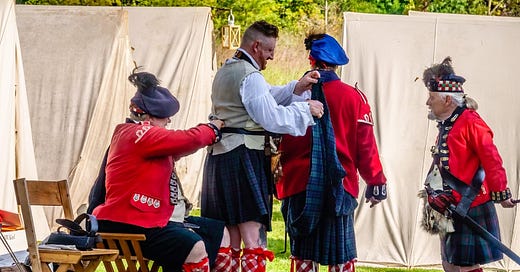The Great Kilt, known in Gaelic as "feileadh mór" meaning “great wrap,” is a traditional Scottish garment that has become an iconic symbol of Scottish heritage. This versatile attire features a long piece of tartan fabric, typically around five to six yards in length, which can be draped and wrapped around the body in various ways. The term "breacan-an-feileadh," translating to “tartan wrap,” further underscores its significance as both a practical garment and a representation of regional identity.
The Great Kilt dates back to the 16th century, with its roots firmly planted in the Highlands of Scotland. Originally, it served as a utilitarian piece of clothing for both labourers and soldiers, offering warmth and protection from the harsh Scottish weather. Its design allowed for easy movement, making it suitable for various activities, from farming to warfare.
To wear the Great Kilt, one typically begins by folding the fabric in half and then wrapping it around the waist, securing it with a belt or straps. The excess material can be draped over the shoulder, creating a cloak-like effect. This style not only provides insulation but also allows the wearer to adapt the garment for different occasions.
The Great Kilt is versatile enough for both everyday use and special events. Traditionally, it would be worn during celebrations such as weddings, clan gatherings, and Highland games. Today, it remains popular for formal occasions, including ceilidhs, festivals, and cultural events. The kilt is often paired with accessories like a sporran, ghillie brogues, and a Jacobite shirt, enhancing its traditional aesthetic.
In addition to its practical applications, the Great Kilt holds deep cultural significance. Each tartan pattern represents different clans or regions, fostering a sense of belonging and identity among Scots. The kilt has evolved over the centuries but continues to be a cherished emblem of Scottish pride, celebrated for its rich history and enduring legacy.
Overall, the Great Kilt is not merely a garment; it is a piece of history that embodies the spirit and resilience of Scotland and its people.





